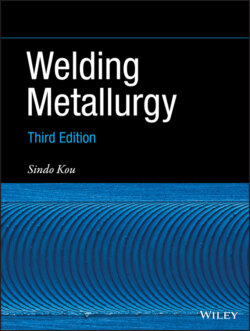Читать книгу Welding Metallurgy - Sindo Kou - Страница 66
2.1.1.3 Heat Source Efficiencies in Various Welding Processes
ОглавлениеFigure 2.8 summarizes the heat source efficiencies measured in several welding processes. A few comments are made as follows:
LBW: The heat source efficiency is very low because of the high reflectivity of metal surfaces but can be significantly improved by surface modifications, such as roughening, oxidizing, or coating.
PAW: The heat source efficiency is much higher than LBW.
GTAW: The heat source efficiency for direct‐current electrode negative( DCEN) is slightly higher than that in PAW because of absence of heat losses from the arc plasma to the water‐cooled orifice gas nozzle and through the bottom of the keyhole.
GMAW, SMAW: Unlike in GTAW, heat transfer to the electrode can be transferred back to the workpiece through metal droplets, thus improving the arc efficiency.
SAW: Unlike in GMAW or shielded metal arc welding (SMAW), the arc is covered with a thermally insulating blanket of molten slag and granular flux, thus reducing heat losses to the surroundings and improving the arc efficiency.
EBW : The keyhole in EBW acts like a “black body” trapping the energy from the electron beam. As a result, the efficiency of the electron beam is very high.
Figure 2.8 Heat source efficiencies in several welding processes.
